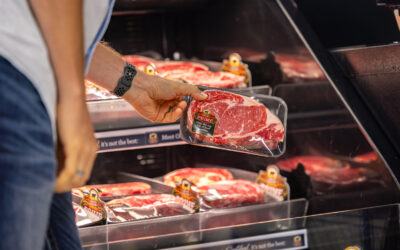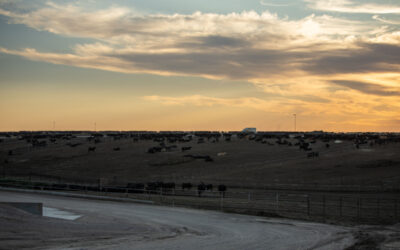
Showing Up, Every Day
Magnum Feedyard earns the 2023 Feedyard Commitment to Excellence award.
By Morgan Boecker
October 2023
It’s still dark when the first tires hit the gravel drive to Magnum Feedyard. The only noise is the hum of the feed mill and crunch of those tires as the crew arrives to begin the day.
“The world is run by people who show up,” says Christie Gabel, quoting one of her dad’s sayings and life lessons. “It’s a good daily motto to get up and go serve your purpose.”
Maybe that’s why sunrise is a favorite time for most of the family. A peaceful moment of illumination so invites participation that even the cattle stir in anticipation of breakfast.The predictable sights and sounds make a fitting start for a business that operates on finely tuned routine.
Thirty-five thousand cattle may fill these pens, but it’s the Gabel family who set the tone for each day. Steve and Audrey persistently create a people-first culture, echoed by their son Case and daughter Christie, who work alongside them in the yard office.
Each family member brings their own strengths to Magnum, near Wiggins, Colorado. Steve brings years of wisdom through tried-and-true practice while Audrey keeps the books and people balanced. Ten years ago, Case moved home and took on risk management and cattle procurement while also managing and owning feedyards in Nebraska. Then in 2021, Christie left her 15-year career in pharmaceutical sales to join her family. She worked her way through each department at the yard before settling in as the cattle clerk.
There are many moving parts at a feedyard, but every detail matters to this family and team. For their drive to effectively hit the high-quality beef target and determination to get better every day, Magnum Feedyard received the Certified Angus Beef (CAB) 2023 Feedyard Commitment to Excellence award. The Gabels were recognized at CAB’s Annual Conference in Las Vegas, Nevada, in September.

Caption: (left to right, back): Harper, Case, Kelsi, Audrey, Stetson & Christie Gabel; (left to right, front) Cavin, Steve, Ansley & Hadli Gabel
Visible Changes
Before Steve owned the feedyard, he was hired to build its customer base. The worn-out wooden pens were stocked with buffalo back then, eating dry-rolled corn from a few cement bunks.
Soon, he and Audrey had the opportunity to buy the place and on July 1, 1994, Magnum Feedyard was born.
“We recognized early on that our survival and our ability to leave anything to the kids meant we had to grow and expand,” Steve says.
The young couple got to work welding new pen structures, splitting them to increase head count from 3,500 to 8,000 and reworked the business model. With each new year came another line of bunks until they reached 22,000-head capacity. The pens shifted to a colorful mix of calves imported from Mexico or Holsteins as their customer base grew.
“When we had an empty pen and someone called, we didn’t have the ability at that point to ask where the cattle are from and what their genetics were,” Steve says. “If we had an empty pen, we took them in.”
A few years ago, another expansion brought capacity to 35,000 head, but uniformity increased this time around. Today, you’ll see mostly black-hided cattle on rations from a steam flaker and an efficient hay processing facility.
Modernizing infrastructure and makeup of cattle called for another change.
Listening to the Market
Most of Magnum’s history was feeding cattle for someone else. Always a student of the markets, however, Steve watched customer report cards in the form of carcass data and payouts, noticing how and when money was left on the table.
This was about the same time Case moved home 10 years ago and picked up cattle procurement and risk management for Magnum.
“One of the bigger changes I’ve seen at the feedyard is a more consistent supply of high-quality feeder cattle,” Case says.
Better cattle led them to negotiate a new marketing agreement with JBS Packing that rewards cattle for hitting high quality targets. Not only are they incentivized to make cattle big, but also produce a carcass that make premium Choice and Prime beef.
They actively seek Angus-influenced cattle of Northern origin with hopes to excel in quality grade and hit a 1,500- to 1,600-lb. end weight. Now, Magnum owns 75% to 85% of the cattle that come through the yard.
“I think the icing on the cake becomes the grid and its potential to return premiums for the right genetic package fed right,” Steve says.
But quality isn’t the only change he’s seen. Better genetics also improved gains and dry-matter conversions. The report card keeps improving, with pens of cattle averaging 40% CAB and 10% Prime – a big improvement from selling on a live basis.
“If you can’t quantify how cattle are going to perform, you can’t really manage your risk against that,” Case says. “With better cattle, you have more predictable performance in all aspects.”

Caption: “There’s a lot of other things that we could do to make money that are easier or don’t take as much work, don’t take as much time,” Dirk Murphy says. But at the end of the day, they’re following their passion and working with people they care about.
Consistent and Accurate
Back to the sunrise scene, feedyard manager Dirk Murphy makes his way through the yard reading bunks to provide the feed truck drivers an updated call for the day. Steers and heifers stand and stretch.
Meals consist of corn, wet distiller grains, liquid protein supplement, alfalfa hay and sometimes dried bakery surplus products. Each pen gets a customized recipe based on their stage of the feeding cycle.
Cattle are creatures of habit, so consistency is vital to each animal’s health and performance, Murphy says. That’s why the first feeding is all about timing and the second is for accuracy.
“There’s a lot of other things that we could do to make money that are easier,” Murphy says. “But this passion we have for this industry is what really drives us. And producing a high-quality end product for consumers.”
Keeping the bunks stocked is the biggest undertaking at the feedyard, closely followed by caring for their health. Research and practice show a correlation between visits to the sick pen and ability to grade Choice, Steve points out.
“We’re not capable of eliminating every potential bad day,” Steve says. “Our job as stockman and caretakers of these animals is to do everything to make the environment as pleasant and performance oriented as we possibly can.”
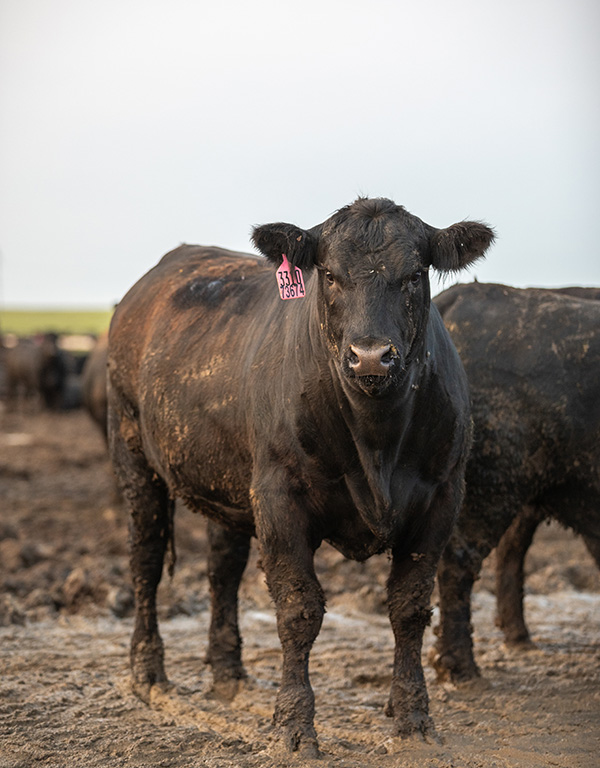
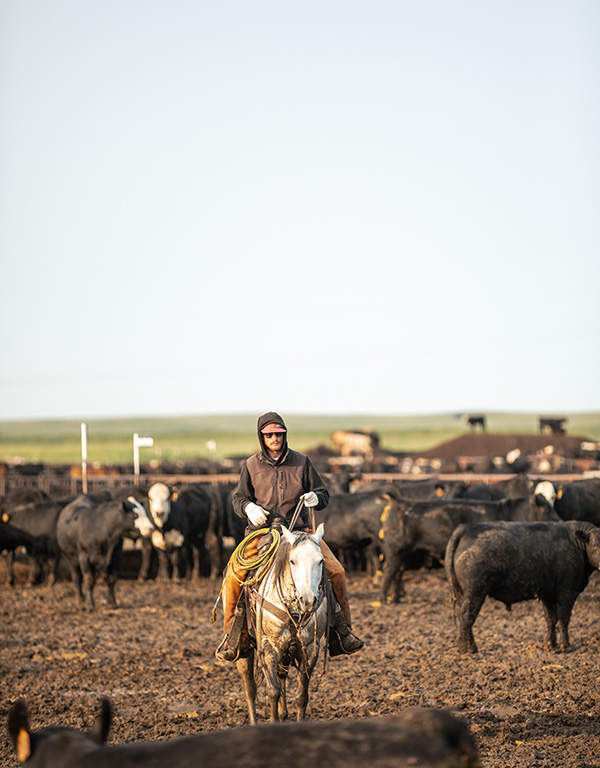
Little Details, Big Results
Above the door between Steve and Case’s office is a sign that says, “three yards a down.” It’s a football recipe for steady progress based on every little bit of work and attention to detail.
Beyond the feedyard, Christie manages their cow-calf operation and Case oversees the farming side that grows crops for Magnum’s use along with silage for local dairies.
“Our ability to manage the little things allows us to leave this place better than we found it,” Steve says.
They compost mortalities through a screening system with end products applied on their farm area alfalfa fields for farmers who supply hay to Magnum. It’s a partnership with the farmers that also secures better quality alfalfa.
Water is a scarce and valuable commodity on the Front Range and Steve is required to report water use monthly. All runoff is captured in holding ponds that meet specific seepage and evaporation rates. The newest section of the feedyard installed a reclaim system where water runs through a gravel-and-sand filter medium and across ultraviolet light, until it’s clean and rejoins the main water supply. Every drop is either consumed and converted by an animal or recycled and reused.
“I want to be a good neighbor, too,” Steve says. “So, at the end of the day, we will continue to invest and research ways to improve our environmental footprint. Not just for water quality, but for sustainability as a whole.”
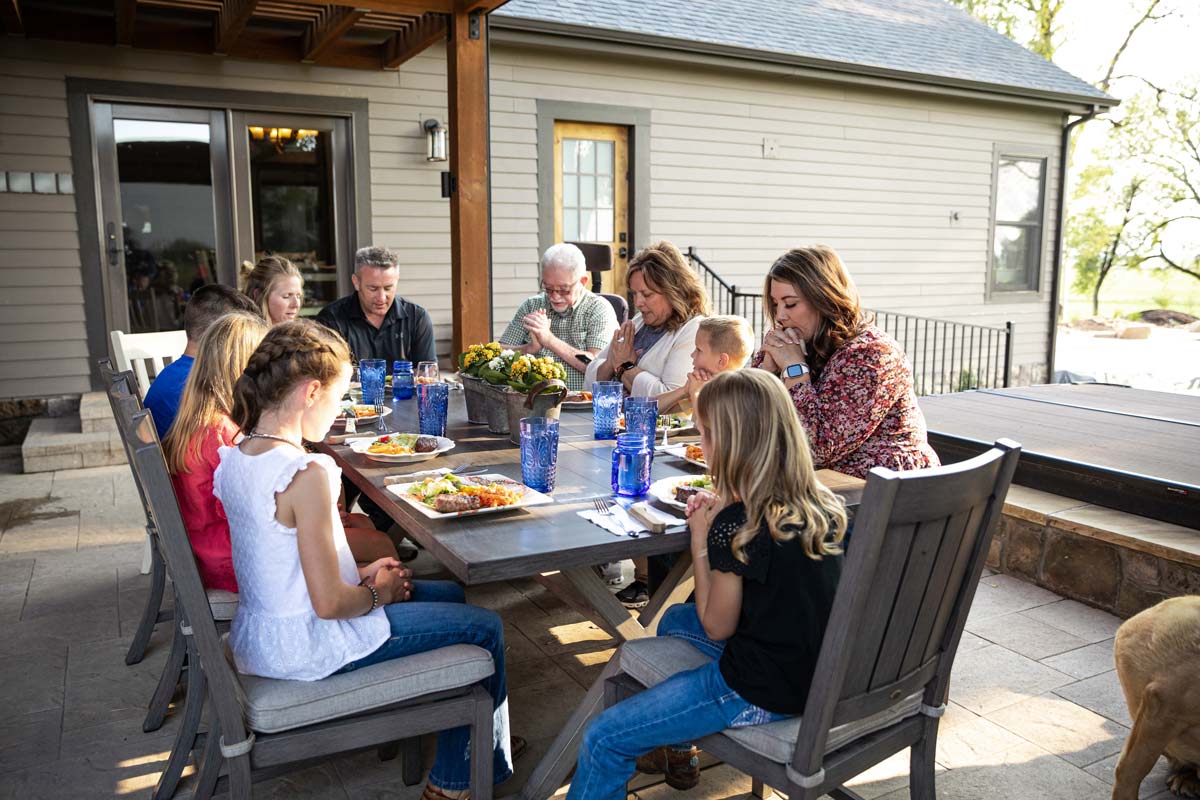
Caption: Why does any of the Gabel’s show up every day? Because it’s their family who’s counting on them.
“Really, the cattle business is a people business,” Case Gabel says. “We trade a lot of dollars, we trade a lot of animals, we trade a lot of risk, but we do it with people that we want to do business with every day.”
Care You Can See
Driving through the feedyard, nothing is out of place. At every sunrise, the yard office is clean for the many feet that will trek in and out of the front door, checking in at the scales.
“The Gabels don’t do anything half-heartedly,” Murphy says. “They would tell you that a half-hearted work ethic receives half-hearted results.”
Whether you’re a feed truck driver, pen rider, office assistant, intern or cattle buyer, your work matters. The average Magnum employee has been there for more than nine years.
“Everybody understands value in their role because mom and dad make people feel valued on top of just telling them they are,” Christie says.
The office buzzes with energy from each of the Gabels; it’s a family full of strong personalities. But it’s a family business where everyone is empowered to make decisions, even if they end in a mistake.
“We’ve had lots of discussions, we’ve had lots of disappointments,” Audrey says. “But with all those disappointments, that’s when we learn the most. That’s when we get the fulfillment of doing it right the second time.”
Progress is rarely a straight trajectory up. It’s more of a jagged line with setbacks and then big jumps forward. Everyone gets the chance to fall but get back up and try again. That’s a lesson the family knows too well.
For more than 20 years, Steve has been confined to a wheelchair managing the feedyard. But he says it’s only strengthened his team of employees and family through greater trust to get the job done. Seeing their kids choose to come back to the family business on their own has made both Steve and Audrey proud.
On the flip side, Case and Christie witnessing their parents’ resilience makes them want to continue the family legacy.
“To keep going in this business, you’ve gotta have a little of a daredevil attitude,” Audrey says. The harder the work ¬–physically and mentally – the more fun it is.
As they transition more responsibility to the next generation, there’s just as much excitement and thrill to chase the moving target of success.
This story was originally published in the Angus Journal.
You may also like
CAB Sets Sales Records, Sees Historically High Brand Acceptance Rates
In an otherwise tough time in the beef business, sales and supply records have been a bright spot. The positive numbers mean that quality beef production has not let up, and beef demand is holding. Consumers have proven the value proposition: the good stuff is worth a little more money, for a better eating experience.
Feeding Quality Forum Dates Set Earlier in August
When you’re feeding cattle, it counts to keep track of every calf, pound and dollar. Beyond the event’s educational sessions, networking between segments of the beef supply chain is invaluable—from feeders and cow-calf operators to allied industry and university researchers.
Every Issue Has Its Moment
Progress happens when people are at the table, engaged and committed to action. With a vested interest in the industry’s future, CAB is leaning in on conversations surrounding evolutions in meat science.

